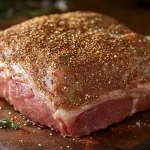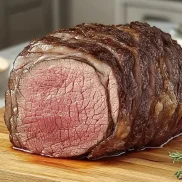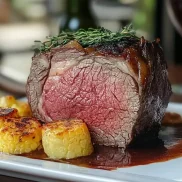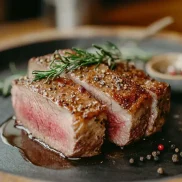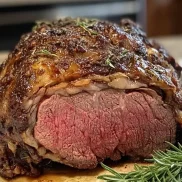Prime rib, also known as a standing rib roast, is the crown jewel of holiday dinners, celebratory feasts, and gourmet gatherings. Known for its rich marbling, tender texture, and robust flavor, this cut of beef is a showstopper that deserves special attention. But what truly elevates a prime rib roast from delicious to unforgettable? The answer lies in the rub. A well-crafted prime rib rub recipe can turn a good roast into an extraordinary one, enhancing its natural flavors while adding a personalized touch.
Creating the perfect prime rib is as much about the preparation as it is about the cooking. The right rub not only seasons the meat but also creates a crust that locks in juices and delivers a delightful contrast to the tender interior. Whether you’re a seasoned chef or a home cook experimenting for the first time, mastering the art of the prime rib rub opens the door to countless culinary possibilities.
In this guide, we’ll explore everything you need to know about prime rib rubs—what they are, why they’re essential, and how to craft the perfect one. Let’s get started!
Table of Contents
What Is a Prime Rib Rub?
A prime rib rub is a blend of spices, herbs, and other ingredients applied to the surface of a prime rib roast. The purpose of the rub is multifaceted: it enhances the flavor, aids in creating a savory crust, and can even tenderize the meat when allowed to marinate. Unlike a marinade, which relies on liquid ingredients to infuse flavor, a rub is typically dry or paste-like, clinging to the surface of the meat without altering its texture.
Rub recipes vary widely, ranging from simple combinations of salt and pepper to intricate blends incorporating exotic spices, fresh herbs, and even sweeteners. Each rub tells a story, reflecting regional influences, personal preferences, and the cook’s creativity. Whether you’re aiming for a classic savory profile or something more adventurous, the rub sets the stage for the prime rib’s overall flavor.
Defining Prime Rib and Its Cuts
To understand the importance of a rub, it’s essential to appreciate the star of the show: the prime rib. Cut from the primal rib section of the cow, prime rib is prized for its rich marbling and tenderness. This section, located between the chuck and the short loin, provides some of the most flavorful cuts of beef.
Prime rib is often sold as a whole roast, containing six to seven ribs, or as individual cuts. The term “prime” can be misleading; while it’s commonly used to refer to this cut, it’s also a USDA grade indicating high quality. Be sure to check whether you’re purchasing USDA Prime or Choice meat, as the former has superior marbling and tenderness.
This cut’s natural richness makes it a perfect canvas for a rub. The marbling melts during cooking, infusing the meat with flavor and creating the ideal base for the spices and herbs in the rub to shine.
Why Use a Rub for Prime Rib?
The prime rib rub is more than a seasoning; it’s a transformative layer that enhances the roast in multiple ways:
- Flavor Enhancement: A rub amplifies the natural taste of the beef, adding depth and complexity. The combination of salt, spices, and herbs ensures every bite is bursting with flavor.
- Crust Formation: As the roast cooks, the rub creates a savory crust that contrasts beautifully with the tender, juicy interior. This crust is where the magic happens—it’s the hallmark of a perfectly cooked prime rib.
- Customization: A rub allows for endless creativity. From classic combinations of garlic and rosemary to exotic spice blends, the possibilities are limitless.
- Juice Retention: The salt in the rub helps draw moisture to the surface, where it mingles with the spices and forms a flavorful seal. This process locks in the juices, keeping the meat tender and moist.
Using a rub is not just about following a recipe; it’s about personalizing the prime rib to suit your taste and the occasion. Whether you’re hosting a holiday dinner or experimenting in the kitchen, a prime rib rub is your ticket to a memorable meal.
Key Ingredients for a Perfect Prime Rib Rub
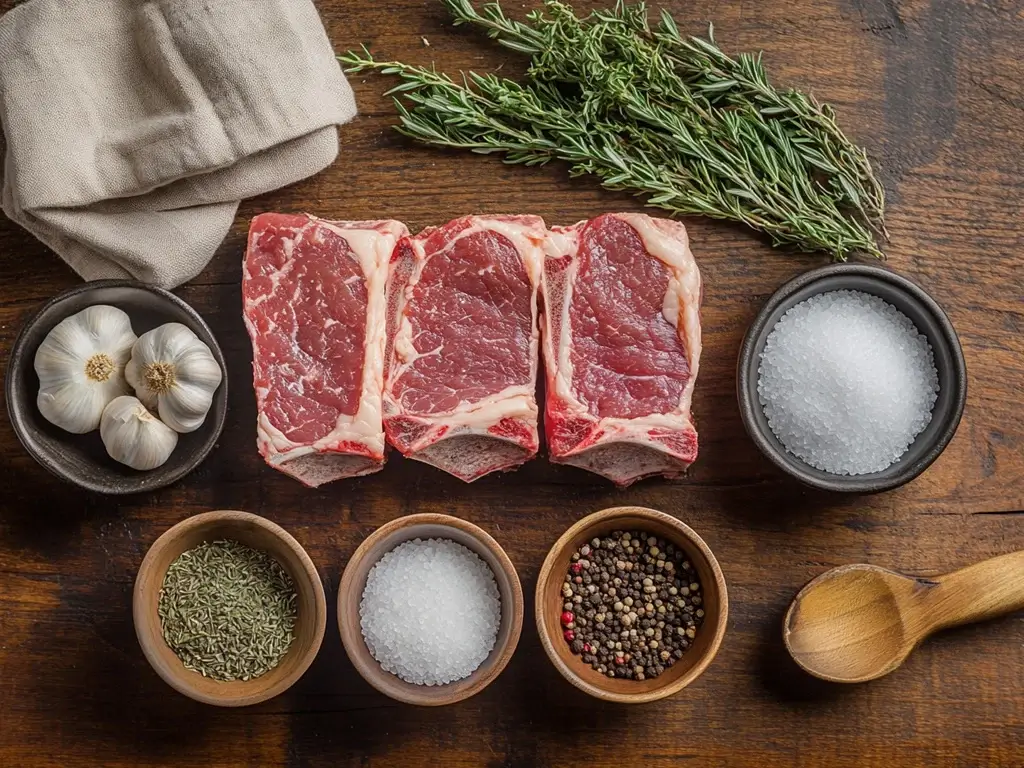
Crafting the perfect prime rib rub begins with understanding the key ingredients that make it exceptional. A well-balanced rub combines essential spices, aromatic herbs, and unique additions to create layers of flavor that complement the richness of the prime rib. Let’s dive into the must-have elements for an unforgettable rub.
Essential Spices for Flavor
Spices form the backbone of any rub, providing bold and aromatic flavors that elevate the prime rib. Here are the essentials:
Salt: The Foundation of Seasoning
Salt is the cornerstone of a great rub. It enhances the natural flavor of the meat by drawing out moisture and intensifying its savory profile. Kosher salt is ideal due to its coarse texture, which clings well to the surface of the prime rib. A generous application ensures the meat is evenly seasoned and creates the foundation for the other ingredients to shine.
Pepper Varieties: Adding Complexity
Black pepper is a classic choice for prime rib rubs, adding a touch of heat and complexity. Opt for freshly cracked black pepper to release its oils and maximize its aroma. For a unique twist, consider incorporating white pepper for subtle heat or smoked pepper for a hint of charred flavor. Each variety brings a distinct dimension to the rub.
Herbs That Elevate the Taste
Herbs are essential for adding freshness and depth to the rub. Rosemary and thyme are traditional choices that pair beautifully with beef, offering earthy and slightly piney notes. Dried oregano or parsley can be added for a more herbaceous profile. If using fresh herbs, chop them finely to ensure even distribution across the roast.
Optional Additions for Unique Flavors
To take your prime rib rub to the next level, consider adding unique ingredients that provide balance and intrigue.
Sweeteners: Balancing Boldness
Sweeteners can enhance the rub by balancing the bold, savory flavors. Brown sugar is a popular choice, adding a touch of sweetness and promoting caramelization during cooking. For a more complex flavor, try maple sugar or honey powder. These options add a subtle sweetness that pairs wonderfully with the savory richness of the beef.
Specialty Ingredients for a Gourmet Touch
For those looking to impress, specialty ingredients can transform a simple rub into a gourmet experience. Smoked paprika adds a smoky depth, while ground mustard seeds provide a tangy sharpness. Crushed fennel seeds or a pinch of cayenne pepper can introduce unexpected flavors that leave a lasting impression. Even a sprinkle of espresso powder can enhance the roast’s natural umami for a bold and sophisticated twist.
Blending the Ingredients
To ensure a harmonious rub, blend all the ingredients in a bowl and mix thoroughly. Taste the mixture to adjust the balance of flavors as needed. Store any excess rub in an airtight container for future use. By mastering these ingredients and techniques, you’ll create a prime rib rub that’s nothing short of spectacular.
Types of Rubs for Prime Rib
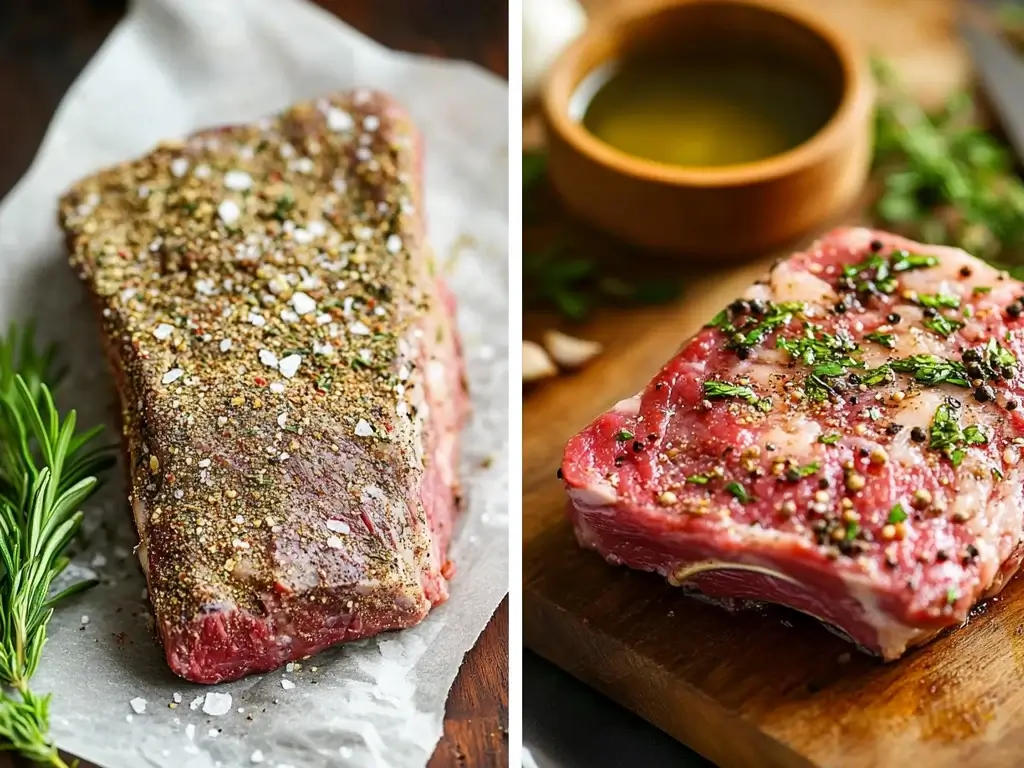
When it comes to seasoning prime rib, choosing the right type of rub can make all the difference. From traditional dry rubs to more intricate wet rubs, each offers unique advantages and flavors. Here’s a closer look at the two main types of rubs and how to use them effectively.
Dry Rubs: Simple and Effective
Dry rubs are the go-to choice for many cooks due to their simplicity and effectiveness. These blends of dry spices and herbs adhere to the surface of the meat, creating a flavorful crust as the roast cooks.
Basic Dry Rub Formula
A basic dry rub for prime rib typically includes:
- 2 tablespoons kosher salt
- 1 tablespoon black pepper
- 1 tablespoon garlic powder
- 1 teaspoon onion powder
- 1 teaspoon smoked paprika
This formula enhances the natural flavor of the beef without overpowering it. It’s an excellent starting point for those new to prime rib rubs.
Advanced Dry Rub Variations
For a more sophisticated flavor profile, consider adding:
- Brown sugar for sweetness and caramelization.
- Ground mustard seeds for a tangy kick.
- Cayenne pepper for heat.
- Dried herbs like thyme, rosemary, or oregano for an herbaceous touch.
To apply a dry rub, pat the prime rib dry with paper towels and evenly coat the entire surface with the rub. Allow the roast to rest in the refrigerator for several hours or overnight to let the flavors penetrate the meat.
Wet Rubs: Adding Moisture and Flavor
Wet rubs are a blend of spices and herbs combined with liquid ingredients, creating a paste-like consistency. These rubs not only season the meat but also add moisture, making them ideal for those who prefer a juicier roast.
Ingredients for a Perfect Wet Rub
A classic wet rub might include:
- 3 tablespoons olive oil or melted butter
- 2 tablespoons kosher salt
- 1 tablespoon minced garlic
- 1 tablespoon Dijon mustard
- 1 teaspoon black pepper
- 1 teaspoon fresh rosemary, chopped
Feel free to adjust the liquid-to-spice ratio to achieve your desired consistency. Additional ingredients like soy sauce, Worcestershire sauce, or lemon juice can introduce new flavor dimensions.
Applying Wet Rubs for Best Results
To apply a wet rub, follow these steps:
- Prepare the Prime Rib: Pat the roast dry and place it on a clean surface.
- Spread the Rub: Use a brush or your hands to coat the roast evenly with the wet rub, ensuring all sides are covered.
- Marinate: Let the roast rest in the refrigerator for a few hours or overnight to allow the flavors to meld with the meat.
- Cook: Place the roast in the oven or on the grill, ensuring the wet rub remains intact during the cooking process.
Choosing the Right Rub for Your Needs
The choice between a dry or wet rub often comes down to personal preference and the desired outcome. Dry rubs excel in creating a flavorful crust, while wet rubs add moisture and a richer flavor profile. For the ultimate prime rib experience, you might even consider combining the two techniques—starting with a wet rub and finishing with a dry rub layer before cooking.
How to Make a Prime Rib Rub from Scratch
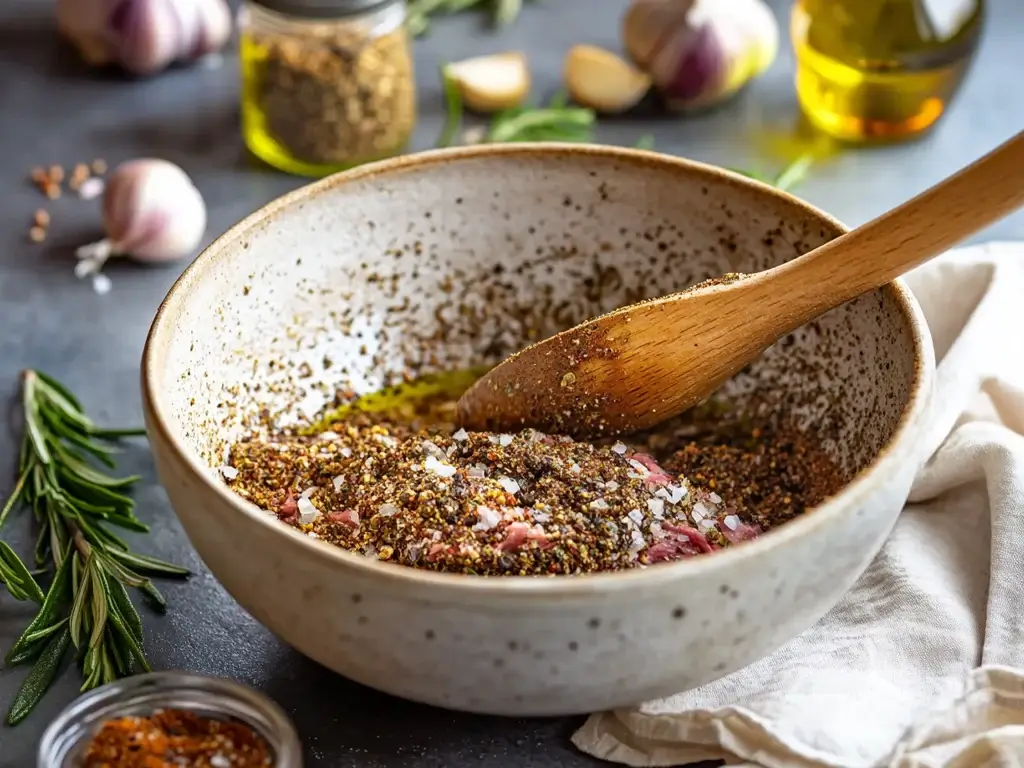
Creating a prime rib rub from scratch is a rewarding process that allows you to customize flavors to suit your taste. Whether you prefer a classic blend or an innovative twist, this step-by-step guide ensures a seamless process for crafting the perfect rub.
Step-by-Step Instructions
Step 1: Gather Your Ingredients
Start by assembling the essentials. A basic prime rib rub requires:
- Kosher salt (2 tablespoons): Enhances natural flavors.
- Freshly cracked black pepper (1 tablespoon): Adds heat and depth.
- Garlic powder (1 tablespoon): Delivers a savory kick.
- Onion powder (1 teaspoon): Adds subtle sweetness.
- Smoked paprika (1 teaspoon): Introduces a hint of smokiness.
- Dried rosemary or thyme (1 teaspoon): For herbal notes.
Optional ingredients for added flair include cayenne pepper for spice, brown sugar for sweetness, or ground mustard seeds for tanginess.
Step 2: Measure and Blend
Using a small bowl, measure each ingredient carefully to maintain balance. Combine all the ingredients and mix thoroughly with a whisk or fork. This ensures the flavors are evenly distributed, preventing any one ingredient from overpowering the others.
Step 3: Test the Flavor Profile
Before applying the rub, taste a small pinch of the mixture. Adjust as needed by adding more salt, pepper, or additional spices. Personalizing the blend at this stage ensures the final result aligns with your preferences.
Step 4: Apply the Rub to the Prime Rib
Pat the prime rib dry with paper towels to help the rub adhere. Generously coat all sides of the roast with the rub, pressing it into the surface to form an even layer. For the best results, apply the rub at least 4 hours in advance and refrigerate the roast, allowing the flavors to penetrate.
Step 5: Cook and Enjoy
Once the rub has infused the prime rib with flavor, it’s time to cook. Whether roasting in the oven or grilling over indirect heat, the rub will form a flavorful crust that enhances every bite.
Common Mistakes to Avoid
Even experienced cooks can make missteps when crafting a prime rib rub. Avoid these common pitfalls to ensure success:
- Skipping the Salt: Salt is the foundation of any rub. Without it, the flavors won’t penetrate the meat effectively.
- Using Stale Spices: Old or expired spices lack the potency needed for a flavorful rub. Always use fresh, high-quality ingredients.
- Over-Seasoning: While a generous application is essential, too much rub can overpower the natural flavor of the prime rib. Balance is key.
- Not Allowing Time to Marinate: Applying the rub just before cooking won’t give the flavors enough time to develop. For optimal results, marinate the roast for several hours or overnight.
- Uneven Application: Failing to coat all sides of the prime rib can lead to inconsistent flavor. Take the time to cover the entire surface evenly.
By following these steps and avoiding common mistakes, you can craft a prime rib rub that elevates your roast to culinary perfection.
The Science Behind Prime Rib Rubs
Understanding the science behind prime rib rubs reveals why these blends are vital for creating a flavorful and tender roast. From the role of salt to the impact of marinating and resting, every element of a rub contributes to the final culinary masterpiece.
How Salt and Spices Enhance Flavor
Salt and spices are more than just flavor enhancers; they work on a molecular level to transform the meat. Here’s how they achieve this:
- Salt as a Flavor Catalyst: Salt penetrates the meat’s surface through a process called osmosis, drawing out moisture and dissolving proteins. This creates a brine-like effect that enhances the natural umami of the beef while tenderizing the fibers. Kosher salt is particularly effective due to its coarse texture, which clings well to the meat and dissolves slowly for even seasoning.
- Spices for Complexity: Spices add depth and aroma to the rub, stimulating taste receptors and enhancing the overall sensory experience. Ingredients like black pepper, garlic, and smoked paprika not only complement the beef’s natural flavors but also introduce layers of complexity that elevate each bite.
- The Maillard Reaction: During cooking, the rub’s sugars and amino acids interact with the meat’s surface, triggering the Maillard reaction. This chemical process creates the crust—a rich, caramelized layer that locks in moisture and adds a savory, nutty flavor.
The Role of Time: Marinating and Resting
Time is a critical factor in the success of a prime rib rub. Proper marinating and resting allow the flavors to penetrate the meat and ensure an even, juicy result.
Marinating: Letting Flavors Infuse
Marinating with a rub involves coating the meat and allowing it to rest for an extended period. Here’s why this step is essential:
- Flavor Absorption: The salt and spices in the rub draw moisture to the surface, where it mingles with the seasonings before being reabsorbed into the meat. This process ensures that the flavors reach deep into the roast rather than remaining on the surface.
- Tenderization: The salt in the rub breaks down muscle proteins, making the meat more tender. This is particularly beneficial for larger cuts like prime rib, where even seasoning can be a challenge.
- Optimal Timing: For the best results, apply the rub at least 4 to 6 hours before cooking. For a more intense flavor, marinate overnight in the refrigerator. Cover the roast loosely to allow airflow while preventing contamination.
Resting: Preserving Juiciness
After cooking, resting the prime rib is just as important as marinating. This step allows the juices to redistribute throughout the meat, ensuring every slice is moist and flavorful.
- The Science of Resting: Heat causes the meat’s fibers to contract, pushing juices toward the center. Resting allows the fibers to relax, redistributing the juices evenly.
- Timing Matters: Rest the roast for at least 15 to 20 minutes before carving. Tent it loosely with aluminum foil to retain heat without trapping steam, which can soften the crust.
By understanding the science behind salt, spices, and timing, you can harness these principles to create a prime rib rub that delivers exceptional flavor, texture, and tenderness every time.
Frequently Asked Questions
Do you use butter or olive oil for prime rib?
Both butter and olive oil can be used for prime rib, but the choice depends on your flavor preferences. Butter adds a rich, creamy flavor and helps create a golden crust. It’s best applied as part of a wet rub, mixed with herbs and spices. Olive oil, on the other hand, provides a lighter flavor and works well in both wet and dry rubs. Extra virgin olive oil is particularly good for infusing with garlic and herbs before applying to the roast. Learn more
What is the best binder for prime rib?
A binder helps the rub adhere to the meat, ensuring even seasoning. Popular options include olive oil, Dijon mustard, and melted butter. Olive oil is a neutral choice that complements any rub, while Dijon mustard adds a tangy flavor that pairs beautifully with beef. Butter, with its creamy texture, is perfect for enhancing richness and helping herbs stick to the surface. Learn more
What is the secret to a good prime rib?
The secret to a good prime rib lies in preparation and attention to detail. Start with a high-quality cut of meat and season it generously with a flavorful rub. Allow the meat to rest after applying the rub, giving the flavors time to infuse. Cooking the prime rib to the correct internal temperature and letting it rest after cooking ensures a tender, juicy roast with a flavorful crust.
How to add flavor to prime rib?
Adding flavor to prime rib starts with a robust rub made from salt, spices, and herbs. Marinate the roast for several hours to allow the flavors to penetrate deeply. During cooking, consider using aromatics like garlic, onions, and rosemary to infuse the roast with additional layers of flavor. You can also baste the roast with butter or beef broth for extra richness.
Should prime rib be cooked covered or uncovered?
Prime rib should be cooked uncovered to ensure the rub develops a flavorful crust. Covering the roast traps steam, which can soften the crust and dilute the flavors. If you’re worried about the meat drying out, use a roasting pan with a rack to keep the roast elevated and baste it periodically with its juices.
Can you prepare prime rib rub in advance?
Yes, preparing the rub in advance is highly recommended. This allows the flavors to meld together, creating a more cohesive blend. Store the prepared rub in an airtight container for up to a week. Applying the rub to the roast and letting it marinate overnight enhances the flavor and tenderness of the prime rib.
Conclusion
Crafting the perfect prime rib rub recipe is an art that combines science, creativity, and quality ingredients. From selecting essential spices to understanding the role of salt and marinating, every step contributes to a flavorful and tender roast. By choosing the right type of rub—dry or wet—and avoiding common mistakes, you can create a prime rib that’s sure to impress.
Whether you’re a seasoned chef or a home cook, this guide empowers you to experiment with flavors and techniques. Don’t be afraid to personalize your rub with unique ingredients that suit your palate. After all, the secret to a memorable prime rib is the love and care you put into its preparation.
So gather your spices, prepare your roast, and savor the joy of a perfectly seasoned prime rib. It’s a culinary centerpiece that will make every occasion unforgettable.

